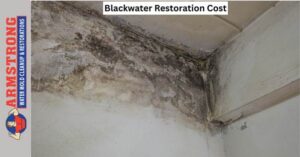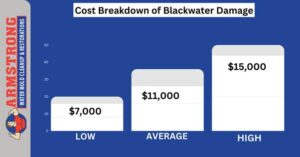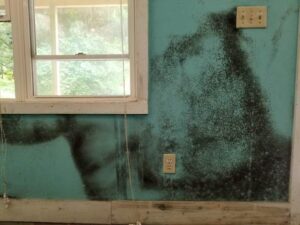
Uncover why fixing blackwater damage in 2025 might leave you broke.
Cost breakdown of blackwater damage
| Cost Type | Low Cost | Average Cost | High Cost |
| Blackwater Restoration | $7,000 | $11,000 | $15,000 |

2025: The year blackwater restoration costs hit new highs—are you prepared?
Type of Blackwater Damage restoration costs
| Type of Blackwater Damage | Description | Cost Range |
| Sewage Backups | Caused by clogged or broken sewer lines; it contains human waste, bacteria, and pathogens. Requires Cleanup of floors, walls, and foundations. | $3,000–$10,000 |
| Floodwater Damage | Occurs during natural disasters; floodwaters contain pollutants like chemicals, pesticides, and sewage. Cleanup is extensive and challenging. | $4,000–$15,000 |
| Toilet Overflows (Category 3 Water) | Involves waste-filled water from toilets (beyond the trap); spreads into carpets, drywall, and subfloors. | $2,500–$8,000 |
| Contaminated Standing Water | Stagnant water classified as blackwater; promotes bacteria, mold, and pathogens. | $3,500–$12,000 |
| Septic Tank Leaks | Untreated wastewater leaks from septic tanks, contaminating soil and groundwater. May require soil remediation and structural repairs. | $5,000–$20,000+ |
Think blackwater Cleanup was expensive last year? 2025 is breaking records, and here’s what’s driving the surge.
Introduction
The blackwater damage restoration cost in Fort Myers, FL is a crucial consideration when addressing water contamination from hazardous sources like sewage backups, floodwaters, and septic tank leaks.
Due to the high risk of harmful bacteria and pathogens, restoration costs in Fort Myers can vary significantly. The blackwater damage restoration cost in Fort Myers typically ranges depending on the severity of the damage, with charges for blackwater damage restoration often being higher than other types of water damage
Homeowners should expect significant blackwater damage restoration expenses, especially when extensive Cleanup, structural repairs, and mold remediation are involved. Understanding these costs upfront can help better manage the financial impact of restoring a safe living environment.
The main types of blackwater damage
Sewage Backups
Caused by clogged or broken sewer lines.
Contains human waste, harmful bacteria, and pathogens.
Can infiltrate floors, walls, and foundations, requiring extensive cleanup.
Floodwater Damage
Occurs during natural disasters like hurricanes, heavy rains, or river overflows.
Floodwaters often contain pollutants such as industrial chemicals, pesticides, and raw sewage.
Spreads contamination across large areas, making cleanup and restoration highly challenging.
Toilet Overflows (Category 3 Water)
Involves waste-filled water from toilets, especially if it originates beyond the trap (i.e., involving sewage).
Can spread quickly to surrounding areas, soaking into carpets, drywall, and subfloors.
Contaminated Standing Water
Water that remains stagnant for extended periods can become classified as blackwater.
Bacteria, mold, and other pathogens thrive in such conditions, making it hazardous.
Septic Tank Leaks
Leaks from septic tanks can release untreated wastewater into nearby areas, contaminating soil and groundwater.
Cleanup is complex and may require soil remediation in addition to structural repair.
Causes and Effects of Blackwater Damage
| Cause | Effects |
| Sewage Backups | Contaminates floors and walls with waste, bacteria, and pathogens, causing health risks. |
| Floodwater Damage | Spreads pollutants, chemicals, and sewage, leading to widespread contamination. |
| Toilet Overflows | Quickly soaks carpets, walls, and floors, creating health hazards and unpleasant odors. |
| Contaminated Standing Water | Promotes mold and bacteria growth, damaging floors and structures over time. |
| Septic Tank Leaks | Pollutes soil and groundwater, requiring cleanup and remediation of the area. |
Don’t let skyrocketing restoration costs catch you off guard—here’s how 2025 changed the game.
Solutions to black water damages
Blackwater damage needs immediate professional action to ensure safety and prevent lasting harm. Solutions include stopping the source, extracting contaminated water, sanitizing affected areas, and removing unsalvageable materials.
Mold remediation, structural repairs, and preventative measures like backflow devices are crucial. Professionals ensure a thorough cleanup, reducing health risks and property damage.
Factors that impact the cost of blackwater damage restoration
| Factor | Impact on Costs |
| Extent of Damage | Larger areas and severe contamination increase cleanup, repair, and material replacement costs. |
| Type of Contamination | Highly toxic or hazardous contaminants (e.g., sewage or chemicals) require specialized handling. |
| Duration of Exposure | Longer exposure leads to greater damage, mold growth, and higher restoration expenses. |
| Materials Affected | Porous materials like carpets and drywall are costly to replace, while non-porous surfaces are easier. |
| Labor and Equipment Needs | Advanced equipment and more labor hours raise overall costs. |
| Location of Damage | Hard-to-access areas like basements or crawl spaces increase cleanup complexity and costs. |
| Local Labor Rates | Costs vary based on regional labor and contractor pricing. |
| Insurance Coverage | Out-of-pocket costs depend on policy coverage and deductibles. |
| Mold Growth | Mold remediation adds significant costs to blackwater damage restoration. |
Blackwater Restoration Cost vs other types of restoration cost
| Type of Restoration | Average Cost |
| Clean Water Damage Restoration cost | $1,000 – $4,000 |
| Greywater Damage Restoration cost | $3,000 – $7,000 |
| Blackwater Damage Restoration cost | $7,000 – $15,000 |
| Flood Damage Restoration cost | $5,000 – $12,000 |
| Commercial Water Damage Restoration cost | $10,000 – $24000 |
| Emergency Water Damage Restoration cost | $3,000 – $10,000 |
| Roof Leak Water Damage Restoration cost | $400 – $25,00 |
| Basement Water Damage Restoration cost | $2,000 – $7,000 |
Sum up
Blackwater restoration costs in Fort Myers, FL in 2025 are climbing due to factors like severe damage, mold growth, and labor rates, averaging $7,000–$15,000. Professional cleanup in Fort Myers is essential to ensure safety, address contamination, and prevent long-term issues. Don’t wait—consult experts in Fort Myers today for thorough and effective restoration.
Schedule a consultation with our certified specialists now!
FAQs
Contaminated water with harmful pathogens from sewage, floods, or stagnant water.
Costs range from $7,000–$15,000, depending on severity and contamination.
Coverage depends on your policy and the damage source.
Typically a few days to weeks, based on the extent of damage.
No, professional help is necessary due to health risks and specialized cleanup needs.
